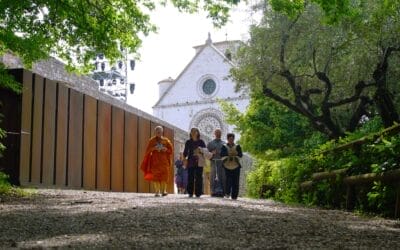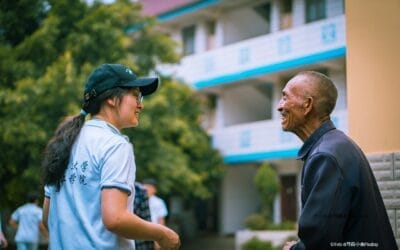 In recent years, Hurgarda, on the Red Sea, and Luxor in the vicinity of Alessandria have been welcoming the Mariapolis of the Focolare Movement. These places are rich in natural and artistic beauty, symbols of the deeply religious, open, hospitable, and joyful Egyptian population who are also endowed with a basic human equilibrium which has resulted from their large capacity for suffering and bearing with adversity. They showed this to the world during the events of December 2011.
In recent years, Hurgarda, on the Red Sea, and Luxor in the vicinity of Alessandria have been welcoming the Mariapolis of the Focolare Movement. These places are rich in natural and artistic beauty, symbols of the deeply religious, open, hospitable, and joyful Egyptian population who are also endowed with a basic human equilibrium which has resulted from their large capacity for suffering and bearing with adversity. They showed this to the world during the events of December 2011.
This history of the spirituality of unity in Egypt reaches back to the end of the 1950’s when Marco Tecilla disembarked in Alessandria for a meeting with one of the first Franciscans who came to know the Movement, Fr Nazareno Beghetto. At the end of 1960 some focolarini from Algeria spent just a few days in Egypt, but in 1975, Aletta Salizzoni went to stay in the land of the Pharoahs along with the Matta family from Lebanon. They had been invited by the Good Shepherd Sisters who, having attended the Mariapolis in that country had begun the first focolare community there.
In the late 1970’s Word of Life groups were spreading. It was through the life in these groups that a group of Gen were born who attended an international convention in Rome, Italy. When they returned home they asked that a focolare be opened there. Their dream came true on 26 January 1981. Aletta arrived in Cairo together with two other focolarine and they found a house in Shoubra. On 13 October 1983 a men’s focolare was also opened.
 In 1982 Fr Morcos Hakim was elected bishop of Sohag (Upper Egypt). This led to a blossoming community of youths and adults in the city and in the surrounding villages: simple poeple, some anable to read or write, who welcomed and lived the Word of Life with commitment. Meanwhile the focolarini and focolarine were taking more trips to other areas of the country. Mariapolises were held both in Cairo and in Sohag. A group of students began to spread the ideal of unity in Assiut as well and, noticing this blossoming of life, Bishop Morcos asked that a focolare be opened in the South as well. In 1995 three focolarine, among them the first Egyptian focolarina, moved to Sohag. From there they took many regular trips, spreading the spirituality of the Movement in Minia, Luxor and Assuan. In the 1980’s a community was begun in Alessandria around Sr. Cecilia, a Salesian. This community continued to flourish even after the death of this religious sister, the members continuing to gather around the Word and sharing how they were trying to live it in their daily lives.
In 1982 Fr Morcos Hakim was elected bishop of Sohag (Upper Egypt). This led to a blossoming community of youths and adults in the city and in the surrounding villages: simple poeple, some anable to read or write, who welcomed and lived the Word of Life with commitment. Meanwhile the focolarini and focolarine were taking more trips to other areas of the country. Mariapolises were held both in Cairo and in Sohag. A group of students began to spread the ideal of unity in Assiut as well and, noticing this blossoming of life, Bishop Morcos asked that a focolare be opened in the South as well. In 1995 three focolarine, among them the first Egyptian focolarina, moved to Sohag. From there they took many regular trips, spreading the spirituality of the Movement in Minia, Luxor and Assuan. In the 1980’s a community was begun in Alessandria around Sr. Cecilia, a Salesian. This community continued to flourish even after the death of this religious sister, the members continuing to gather around the Word and sharing how they were trying to live it in their daily lives.
But in the meantime many other elements of the Focolare were beginning to appear – many priests and seminarians embraced the spirituality of unity – Focolare families began to have an impact in their local areas that was much appreciated. A group for couples was formed around an Italian and Lebanese husband and wife that later led to the creation of a formation centre for engaged and young married couples. This centre offered courses in marriage life, motherhood, fatherhood, and welcoming the gift of new life. With the encouragement of the Conference of Bishops and of Patriarch Stephanos II, this centre was relocated within the walls of the Patriarchate.
The Focolare in Egypt today has a clearly ecumencial character: a community composed of members of the Catholic Church, several Eastern Rite Churches and the Coptic Orthodox Church. Many rediscover the beauty of their own Churches and become involved in making them more beautiful according to the design of God for them. This ecumenism demonstrates that the diaologue of life permits prejudices that have sometimes existed for centuries, to be overcome..
New relationships have developed not only among Christians (10% of the population), but also with Muslims, and this encourages and spreads hope and certainty that a united world is possible beyond our differences.
By Roberto Catalano




0 Comments